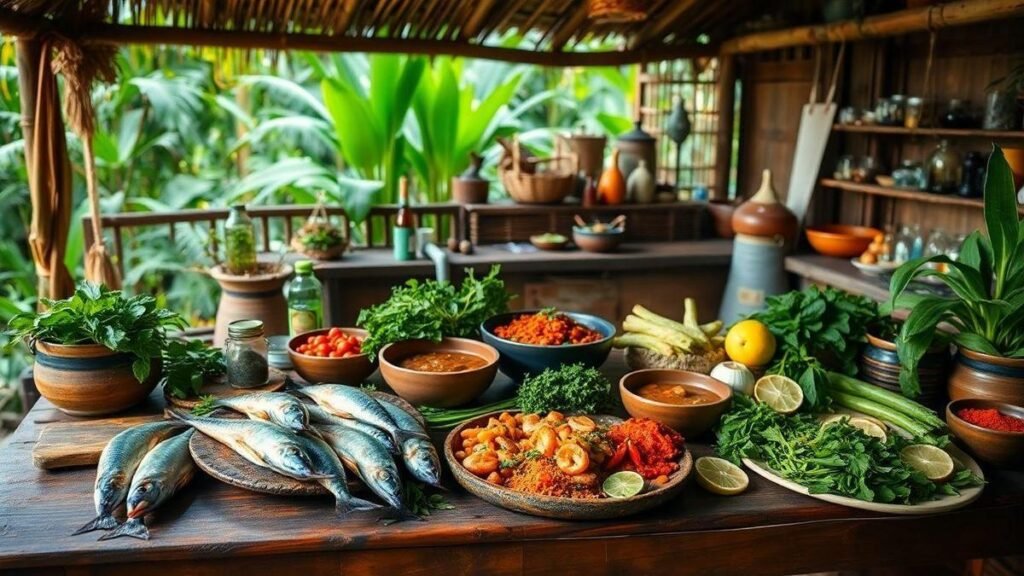Traditional Amazonian recipes for sustainable seafood from the rainforest

Are you ready to dive into Traditional Amazonian recipes for sustainable seafood from the rainforest? This article will take you on a flavorful journey through the unique ingredients, cooking techniques, and cultural traditions of the Amazon. You’ll learn how sustainable practices not only protect the environment but also bring delicious meals to your table. Let’s explore the importance of community, indigenous seafood traditions, and how you can enjoy eco-friendly seafood while preserving a rich culinary heritage.
Contents
ToggleImportant Points to Remember
- Enjoy tasty seafood using rainforest recipes.
- Choose sustainable fish to help the ocean.
- Try fresh ingredients for the best flavors.
- Learn cooking methods from Amazonian traditions.
- Share your meals with friends and family!
Discovering Traditional Amazonian Seafood Recipes
The Importance of Sustainable Rainforest Cuisine
When you think of the Amazon, what comes to mind? Lush trees, vibrant wildlife, and, of course, delicious seafood! The Amazon rainforest is not just a treasure trove of biodiversity; it’s also a source of sustainable culinary delights. Traditional Amazonian recipes for sustainable seafood from the rainforest are rooted in respect for nature. By using local fish and plants, you not only enjoy incredible flavors but also help protect the environment.
Eating sustainably means you’re making choices that support the health of our planet. Imagine enjoying a meal that not only satisfies your taste buds but also honors the ecosystem. This approach is like a two-for-one deal: you get to feast on amazing dishes while keeping the rainforest thriving.
Unique Ingredients in Amazonian Fish Dishes
What makes Amazonian seafood dishes stand out? It’s all about the ingredients! Here’s a quick look at some standout items you might find:
| Ingredient | Description |
|---|---|
| Tucupi | A yellow sauce made from wild manioc, often used in fish dishes. |
| Jambu | A local herb that adds a unique, tingling sensation to meals. |
| Pupunha | A palm fruit with a sweet taste, often used in salads. |
These ingredients are not just tasty; they also tell a story. Each one carries the heritage of the Amazon, connecting you to the land and its people. When you cook with them, you’re joining a long tradition of culinary creativity.
How Traditional Fishing Methods Protect the Ecosystem
Now, let’s talk about fishing! Traditional fishing methods in the Amazon are all about balance. Local fishermen use techniques that have been passed down for generations. They know that overfishing can hurt the environment, so they fish in ways that keep fish populations healthy.
Here are some methods they use:
- Hand fishing: This method is gentle and ensures that only what’s needed is caught.
- Fish traps: These are designed to catch fish without harming the ecosystem.
- Seasonal fishing: Fishermen only catch certain fish during specific times of the year, allowing populations to recover.
By using these methods, local communities help protect the delicate balance of the Amazon. When you choose to enjoy traditional Amazonian seafood, you’re also supporting these sustainable practices.
Eco-Friendly Seafood from the Amazon
Benefits of Sustainable Aquaculture Practices
When you choose sustainable aquaculture, you’re not just making a smart choice for your plate. You’re also helping to protect the environment. Here are some key benefits:
- Less Overfishing: Sustainable practices help reduce the pressure on wild fish populations.
- Healthier Ecosystems: By farming fish responsibly, we can maintain the balance of the aquatic ecosystem.
- Support Local Communities: Many sustainable farms work closely with local communities, providing jobs and boosting the economy.
Cooking Techniques for Rainforest-Inspired Seafood Meals
Cooking seafood from the Amazon can be a delightful adventure. Here are some techniques to bring those rainforest flavors to your kitchen:
- Grilling: This method adds a smoky flavor that pairs well with many Amazonian spices.
- Steaming: A gentle way to cook fish, preserving its natural taste and nutrients.
- Ceviche: A refreshing dish where fish is marinated in citrus juices, perfect for hot days.
Why You Should Choose Eco-Friendly Seafood
Choosing eco-friendly seafood is like giving a high-five to Mother Nature! Here’s why it matters:
- Health Benefits: Fish from sustainable sources often have fewer toxins and are richer in nutrients.
- Flavor: Fresh, responsibly sourced seafood tastes better. You can really taste the difference!
- Future Generations: By supporting sustainable practices today, you’re helping to ensure that future generations can enjoy the same delicious seafood.
| Benefit | Description |
|---|---|
| Healthier Seafood | Lower in toxins, higher in nutrients |
| Better Taste | Fresh fish has a richer, more vibrant flavor |
| Environmental Impact | Supports healthy ecosystems and reduces overfishing |
Indigenous Seafood Traditions and Their Impact
Learning from Amazonian Culinary Techniques
When you dive into Amazonian culinary techniques, you discover a treasure trove of knowledge. The indigenous people have been cooking with local seafood for generations. They know how to use every part of the fish, from the meat to the bones. This approach not only reduces waste but also respects the environment.
For example, many Amazonian tribes use smoking and drying methods to preserve fish. This technique allows them to enjoy seafood long after fishing season ends. You might find it fascinating that some communities even use herbs and spices from the rainforest to enhance the flavors. It’s a beautiful way to connect with nature and honor the land.
Preserving Culture Through Traditional Amazonian Seafood Recipes
Traditional Amazonian recipes for sustainable seafood from the rainforest are more than just meals; they are a way of life. These recipes tell stories of the past and keep cultural practices alive. By cooking these dishes, you are not just feeding your body but also nourishing your soul.
Here are a few traditional recipes you might want to try:
| Dish | Main Ingredient | Cooking Method |
|---|---|---|
| Fish with Tucupi | Fresh Amazonian Fish | Stewed with Tucupi sauce |
| Jambú Soup | Jambú leaves | Boiled with fish and spices |
| Grilled Pirarucu | Pirarucu fish | Grilled over an open flame |
Each dish carries a piece of the Amazonian spirit. By sharing these recipes with friends and family, you help keep the culture alive. It’s like passing down a family heirloom, but instead, it’s a recipe that warms the heart.
Frequently Asked Questions
What are Traditional Amazonian recipes for sustainable seafood from the rainforest?
Traditional Amazonian recipes for sustainable seafood from the rainforest use local fish and ingredients. They focus on cooking methods that respect nature.
How can I make a sustainable seafood dish at home?
You can start by sourcing local, fresh fish. Try grilling or steaming it with rainforest herbs. This keeps your dish tasty and eco-friendly!
What types of fish are commonly used in Amazonian recipes?
Common fish include tambaqui, pirarucu, and surubim. These fish are widely found in the Amazon and are important for local diets.
Are there vegetarian options in Traditional Amazonian recipes?
Yes, there are! You can find recipes using fruits, vegetables, and nuts from the rainforest. These options are just as delicious and sustainable.
Why is sustainability important in cooking seafood from the rainforest?
Sustainability helps protect fish populations and their habitats. It ensures that future generations can enjoy the beauty and flavors of the Amazon.
